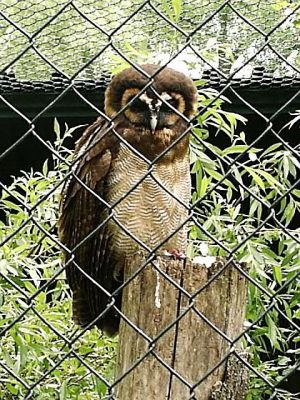The ahool is a flying cryptid, a legendary giant bat, or by other accounts, a pterosaur.
Etymology
Named for its distinctive call "A-hool".
Description/Morphology
The ahool is described as having a monkey/ape-like head with large dark eyes, large claws on its forearms approximately the size of an infant, and a body covered in gray fur. Possibly the most intriguing and astounding feature is that it is said to have a wingspan of 3 m 10 ft. This is almost twice as long as the largest known bat in the world, the common flying fox.
Places
The ahool is said to live in the deepest rainforests of Java.
Origin
According to Loren Coleman and Jerome Clark, The ahool was first described by Dr. Ernest Bartels while exploring the Salak Mountains on the island of Java.
Theories about origin and existence
- One speculation on its existence by the cryptozoologist Ivan T. Sanderson is that it might be a relative of Kongamato in Africa. Others have suggested it were a living fossil pterosaur, on account of its supposedly leathery wings. As is known today, most pterosaurs seem to have had wings that were covered with a downy fluff to prevent heat loss; this may or may not have been necessary in a tropical environment depending on these animals' metabolism.
- What about some existing bird like the owl? Two large earless owls exist on Gotham, the Spotted Wood-owl (Strix seloputo) and the Javan Wood-owl (Strix (leptogrammica) bartelsi). They are intermediate in size between the Spotted Owl of North America or the Tawny Owl of Eurasia, and an eagle owl (horned owl), being 40-50 cm (16-20 in) long and with a wingspan of perhaps 1.20 meters (4 ft). Despite this discrepancy, wingspans are usually overestimated in flying animals not held in hand, especially by frightened observers.
Size nonwithstanding, the Javan or Bartels's Wood-owl seems an especially promising candidate to resolve the ahool enigma: it has a conspicuous flat "face" with large dark eyes exaggerated by black rings of feathers and a beak that protrudes but little, and it appears greyish-brown when seen from below. Its call is characteristic, a single shout, given intermittently, and sounding like HOOOH!. Like most large owls, it is highly territorial in breeding season and will frighten away intruders by mock attacks from above and behind. Its flight, being an owl, is nearly completely silent, so that the victim of such sweeps usually becomes aware of the owl when it is homes in snarling and with outstretched talons (held at "breast" height to the observer), and would just have time to duck away. The Javan Wood-owl is a decidedly rare and elusive bird not often observed even by ornithologists, and hides during day. It is found in remote montane forest at altitudes of probably around 1,000-1,500 meters, and does not tolerate well human encroachment, logging and other disturbances.
References
- Coleman, Loren & Clark, Jerome (1999): Cryptozoology A to Z: the encyclopedia of loch monsters, Sasquatch, Chupacabaras, and other authentic mysteries of nature. Fireside, New York. ISBN 0-684-85602-6
- Holt, Denver W., Berkley, Regan; Deppe, Caroline; Enríquez Rocha, Paula L.; Olsen, Penny D.; Petersen, Julie L.; Rangel Salazar, José Luis; Segars, Kelley P. & Wood, Kristin L. (1999): Family Strigidae (typical owls). In: del Hoyo, J.; Elliott, A. & Sargatal, J. (eds): Handbook of Birds of the World, Volume 5: Barn-owls to Hummingbirds: 76-242, plates 4-20. Lynx Edicions, Barcelona. ISBN 84-87334-25-3
- Shuker, Karl (2003): The Beasts That Hide From Man. Paraview, New York.ISBN 1-931044-64-3

